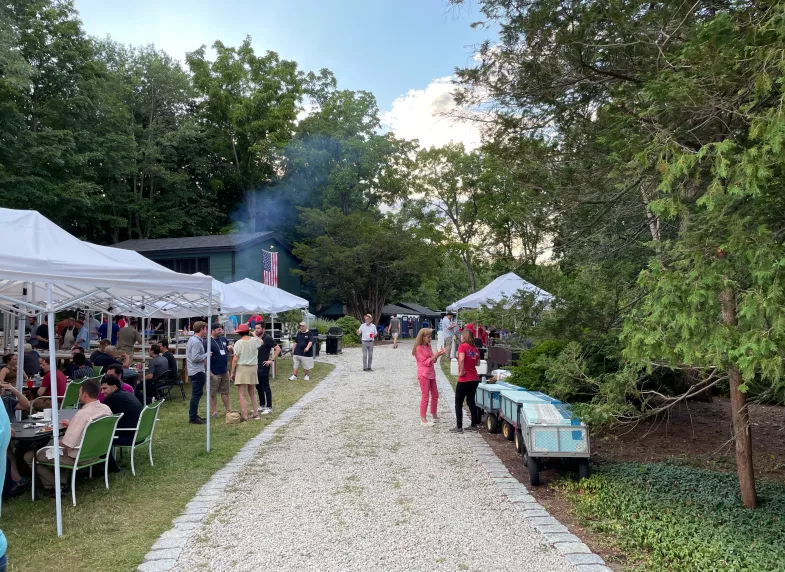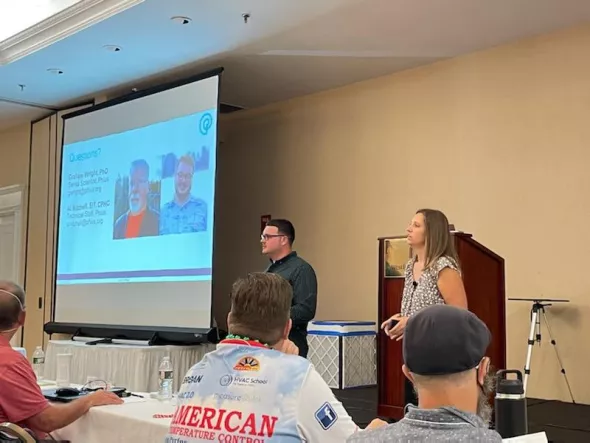Tales from Building Science Summer Camp 2022
Phius Product Certification Manager Michael Franco chronicles his experience at the Westford Symposium on Building Science – also known as “Building Science Summer Camp.”
Phius Product Certification Manager Michael Franco chronicles his experience at the Westford Symposium on Building Science – also known as “Building Science Summer Camp.”

I am not a building scientist – a fact that comes as a surprise to most folks I’ve met through my endeavors at Phius. Thankfully, I don’t think anyone in the industry holds it against me. I am, however, a self-proclaimed geek; with that designation comes a tendency to zero in on anything that piques my interest and learn all I can about it.
My technical knowledge pre-Phius stems from exposure to family members who possess actual technical training and my previous job where I sold industrial supplies. I can safely operate a miter saw, install a radiator in your car, and bore you with details on hose clamps. But don’t let me near your house if it involves anything more complicated than hanging a TV or some shelves. Fortunately, this humble base of mechanical know-how allowed the very patient and knowledgeable Phius technical staff to help me grow my understanding of and appreciation for building science. I know enough about construction and high-performance to know that I don’t know much, but what I can comprehend fascinates me.

Given my background, I was thrilled and somewhat intimidated to have received an invite to join the Phius delegation at the Twenty-Fourth Westford Symposium on Building Science, also known as Building Science Summer Camp. I knew I was in for a lot. Tales of this fabled “Summer Camp” were plentiful and made one thing clear: this was the event of the year for building science practitioners. The agenda outlined three days of detailed, technical presentations complete with an unparalleled lineup of food and drink at the residence of our camp counselors, Betsy Pettit and Joe Lstiburek, which they dubbed the “the official summer camp clubhouse.”
Now, while I may be the new kid on the block with regard to high-performance buildings, I’m certainly no stranger to a good backyard barbecue. Decades of family cookouts have yet to diminish my excitement for grilled foods of any kind, and I like to consider myself an accomplished home cook. In hindsight, I was utterly unprepared for the scale of what I was about to witness. To say Joe and Betsy were gracious hosts would be the understatement of the century. I thank them both for their generous hospitality and welcoming spirit.
To call the clubhouse gatherings simple backyard barbecues borders on criminal. Upon arrival at Joe and Betsy’s, a plume of grill smoke and the buzz of attendees’ conversations led us around the side entrance to the backyard area. It was a sight to behold. What I believed to be grill smoke (singular) was actually about a dozen grills running full tilt plus a large smoker on a towing trailer, with a team of Texans in matching red TAMLYN shirts at the helm. The inside area featured the Building Science Boogie Band and a full bar, both hardly ever at rest. Well-known building scientist and Summer Camp Chef Paul Lagrange treated us to a Cajun feast on our first night in town.
As I mentioned, I know my way around a kitchen. I’ve even had the pleasure of cooking holiday dinners with my wife for our extended family of about 25 people. But I was absolutely floored at just how well-prepared and delicious all the food was over the duration of the event. Course after course of treats appeared each night ranging from avocado and shrimp salad to ribeye steaks, fried oysters, gumbo, Texas brisket, ribs, sweet potatoes (I could go on). I estimate that, at minimum, about 300-400 people partook in this decadent buffet. Cooking at this scale with this quality is beyond impressive — a blend of pure talent and hard work. Thank you all for sharing that with us.

Not to be shown up by the post-presentation culinary display, the presenters at the Westford Regency brought with them anywhere from 45 to 90 minutes of technical, in-depth material, often with credentials with character counts that rivaled my full legal name. These accomplished experts brought us information on medicine, physics, architecture, fire, flooding and chemistry. A high point for me was being able to see my colleagues, Lisa White and Al Mitchell, present their work on grid-building interaction and plans for a complex phased retrofit. I may be biased, but I heard many attendees agree that they hit back-to-back home runs.
Another highlight for me was Dr. Stephanie Taylor’s discussion on occupant health and how it relates to relative humidity and overall building design. Despite a lack of any other physicians in the audience, Dr. Taylor’s presentation was digestible and thought-provoking. The Q&A portion that followed also proved to be one of my favorites as the engineers in the room sought to weigh the risks of higher humidity to building assemblies against those attributed to occupant health when low humidity situations occur. I look forward to hopefully hearing about further research at future conferences in an era defined by the COVID-19 pandemic and a sharp focus on indoor air quality.
While impossible to effectively summarize the building science event of the year in a blog post, my hope is that this newcomer’s perspective can serve as my sincere thanks to Joe, Betsy, and everyone involved with the planning and execution of this event. I’m grateful to everyone in attendance for welcoming me and for the chuckles at my answer of “I’m a parts geek” when asked about my role at Phius. From one type of geek to all the others, thank you. You’re a cool, special bunch and I hope you know that.